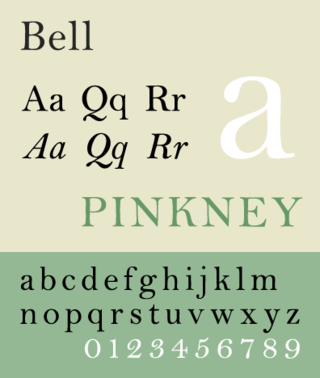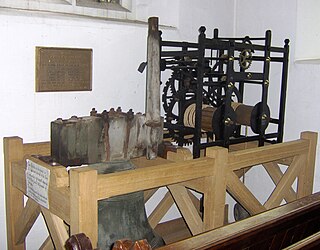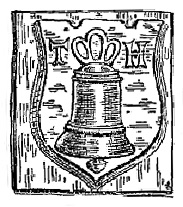
Paul Revere was an American silversmith, military officer and industrialist who played a major role during the opening months of the American Revolutionary War in Massachusetts, engaging in a midnight ride in 1775 to alert nearby minutemen of the approach of British troops prior to the battles of Lexington and Concord.

The Whitechapel Bell Foundry was a business in the London Borough of Tower Hamlets. At the time of the closure of its Whitechapel premises, it was the oldest manufacturing company in Great Britain.

Campanology is the scientific and musical study of bells. It encompasses the technology of bells—how they are founded, tuned and rung—as well as the history, methods, and traditions of bellringing as an art.

A bell is a directly struck idiophone percussion instrument. Most bells have the shape of a hollow cup that when struck vibrates in a single strong strike tone, with its sides forming an efficient resonator. The strike may be made by an internal "clapper" or "uvula", an external hammer, or—in small bells—by a small loose sphere enclosed within the body of the bell.

Andrew Leamy was a pioneer industrialist and community leader in Wright's Town, Lower Canada, which became Hull, Quebec and is now incorporated into the City of Gatineau in the National Capital Region of Canada.

Sand casting, also known as sand molded casting, is a metal casting process characterized by using sand—known as casting sand—as the mold material. The term "sand casting" can also refer to an object produced via the sand casting process. Sand castings are produced in specialized factories called foundries. In 2003, over 60% of all metal castings were produced via sand casting.

A standing bell or resting bell is an inverted bell, supported from below with the rim uppermost. Such bells are normally bowl-shaped, and exist in a wide range of sizes, from a few centimetres to a metre in diameter. They are often played by striking, but some—known as singing bowls—may also be played by rotating a suede covered mallet around the outside rim to produce a sustained musical note.

A foundry is a factory that produces metal castings. Metals are cast into shapes by melting them into a liquid, pouring the metal into a mold, and removing the mold material after the metal has solidified as it cools. The most common metals processed are aluminum and cast iron. However, other metals, such as bronze, brass, steel, magnesium, and zinc, are also used to produce castings in foundries. In this process, parts of desired shapes and sizes can be formed.
Royal Eijsbouts is a bell foundry located in Asten, Netherlands.
Bellfounding is the casting and tuning of large bronze bells in a foundry for use such as in churches, clock towers and public buildings, either to signify the time or an event, or as a musical carillon or chime. Large bells are made by casting bell metal in moulds designed for their intended musical pitches. Further fine tuning is then performed using a lathe to shave metal from the bell to produce a distinctive bell tone by sounding the correct musical harmonics.

Russian Orthodox bell ringing has a history starting from the baptism of Rus in 988 and plays an important role in the traditions of the Russian Orthodox Church.

Bell is the name given to a serif typeface designed and cut in 1788 by the punchcutter Richard Austin for the British Letter Foundry, operated by publisher John Bell, and revived several times since.

The Bilbie family were bell founders and clockmakers based initially in Chew Stoke, Somerset and later at Cullompton, Devon in south-west England from the late 17th century to the early 19th century.

The McShane Bell Foundry, located in St. Louis, Missouri, is a maker of church bells founded in 1856. Over the past 150 years, the firm has produced over 300,000 bells. In 2019, the company moved its headquarters from Glen Burnie, near Baltimore, Maryland to St. Louis Missouri, as it centralized its manufacturing and shipping.
Marinelli Bells – Pontifical Bell Foundry is a bell foundry in Agnone, Italy. Founded no later than 1339, the foundry is one of the oldest family businesses in Italy. In addition to bells, it produces bronze portals, bas-reliefs, and various church artifacts, as well as restoring worn or damaged bells.

Andrew Leamy was a pioneer industrialist and community leader in Wright's Town, Lower Canada, which became Hull, Quebec and is now incorporated into the City of Gatineau in the National Capital Region of Canada.

Henry Northey Hooper was a 19th-century American manufacturer and merchant of decorative lighting, Civil War artillery, and bells and chimes. He was a Boston politician and foundry owner and in his firm he cast the first life-size bronze statue in the United States.

The Haileybury Chapel, Melbourne is the chapel of Haileybury College and Haileybury Girls' College, located at the College's Keysborough campus in south-eastern Melbourne, Victoria, Australia. The chapel is located on the eastern side of Springvale Road, just south of the intersection with Cheltenham Road, in Keysborough.

The Hatch bell foundry at Ulcombe, near Maidstone, in Kent, England, was operated by three generations of the Hatch family from 1581 or earlier until 1664. The bellfounders were based at nearby Broomfield from about 1587 until at least 1639. Joseph Hatch, bellfounder from 1602 to 1639, cast at least 155 bells, including "Bell Harry", after which the central tower of Canterbury Cathedral is named. Most Hatch bells were used in churches east of the River Medway in East Kent.

The Olsen Nauen Bell Foundry is a Norwegian bell foundry located in the municipality of Tønsberg. The foundry was established in 1844 by Ole Olsen, and it is headed today by the sixth generation of the Olsen Nauen family. The company is based at the Nauen farm in Sem and is Norway's only bell foundry.















